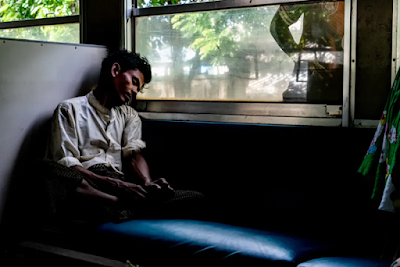... Some add quickly, perhaps because they are afraid of my response, that it must feel like a huge void. A "crater in my living room", around which I must navigate all life. Some tentatively express the hope that I should be feeling better now, compared to how I did months ago on that fateful morning. They seem to be hoping that the silence in my heart is no longer so loud and deafening, that off and on a little birdie might be chirping in there.
Is this the thick darkness at 3am which fades gradually when the dawn breaks? Losing her feels like losing my right eye. That blank stare, that dark half, will stay with me forever. The world will never seem the same to me again.
Nevertheless, I feel like getting up and searching hard in my disheveled heart, to answer them. I am grateful that they asked. I am grateful that they care enough about me to ask. They too knew her, loved her, lost her suddenly, they too say they miss her terribly, but somehow they seem to think that I can voice it better. Did they ask me so they can better define how they are feeling? Did they ask me so I can put their hazy, uncomfortable grief into logical words? Are they hoping that my grief is hopefully deeper, more concrete? Or was their question just a casual ice breaker? Are they merely, uninterestedly, curious if/when I will ever unfreeze? In any case, I will attempt to answer them. But, are they right to conclude that my loss is deeper just because I got lucky to get the largest chunk of her time (May 18th, 1990, 2pm to October 26, 2022, 7am)? Just because she chose to embrace my home and family as hers, to intertwine her and my professions for life, to create our child in her womb? I am not sure. Are loss and grief of human beings measurable in terms that afford a comparison, a sorting? Isn't everyone's emptiness endless, once it is experienced? That question moves the problem from loss to love. Can the loves different people had for her be measured in units that afford a comparison, a sorting? Is loss proportional to how long you loved someone - I wonder.
Unequivocally, however, I feel her loss. Through the whole expanse of my existence, I feel lost. In my heart, my senses, my thoughts, my moments, my spaces, my future, my past. My very being feels sort of like Swiss cheese - full of holes. Also, moments have become elastic. Each one keeps stretching aimlessly. There is no urgency to get anything done, to reach anywhere. Each moment gifted to me by the Present, expands and draws on. Blankly, its taste and flavor get spread, diluted, for a long stretch. Joyous or grievous, all moments stretch on, leaving their lingering but faint flavor for a long time. Each moment hovers around purposelessness, detachment, neutrality. It seems mind is finding a strange comfort in lazily stretching, suspending, and diluting moments. The hard ones, the discomforts, are the transitions, between moments, moods or tasks. May be it is because transitions need some reason, some purpose. That is the main thing I seem to have lost with her, my sense of purpose.
Before she left, spiritual knowledge apart, I was pretty sure that I was doing my life. That feeling left with her. Now I merely watch my life as it rolls on. Like the quiet, drowsy guy sitting by the train window watching the word roll - at a pace that he does not control, with scenes he cannot anticipate. The guy who is merely, implicitly, grateful for the comfortable seat he is given, for the occasional food and drink offered to him, the guy who is detachedly glued to the rolling world before him. He feels no strong emotion about what he watches, no specific thing catches his attention for over a fleeting moment. When she left, I transitioned from being my life's doer to being it's weakly curious, implicitly grateful, mere bystander and watcher.
There is a fear though. That I might be asked to get off the train. To actually be part of those crowded streets, to get something done, to interact with some of those strange faces. That scares me. I hope someone lets me sit in this soft seat, at this nice window, until the final station. I hope my eyes will close off comforted by the fading lights and rolling sights. I hope I deliciously fall asleep, never having to get up or get down.





